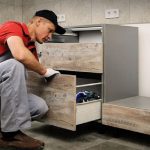How We Mine for Gold
Bendigo Mining’s Swan decline (underground tunnel) now stretches for a distance of some 6.5 km to a depth of about 850 metres beneath the City of Bendigo, tunnelling deep beneath the historic workings to access new untouched orebodies on the Deborah and Sheepshead lines of reef.
Mining
From the decline, diamond drilling is carried out using a diamond bit at typically 120 m intervals to establish the location and dimensions of the ore bodies. Geologists log and cut the diamond drill core samples and send them away for assay to determine the grade of gold on each section of the reef.
With the grade and shape of the reef established, mining engineers are then able to plan the ore shapes that will be mined (the stopes) and determine how the orebody will be accessed and mined. Extracting and removing the ore is achieved by drilling holes in the rock face, packing them with explosives (charging the face) and then blasting the rock.
The blasted rock is loaded into trucks which haul the ore to the surface stockpile at the processing plant to extract the gold. On a busy day, it can take underground trucks more than an hour to complete a round trip to the surface. At full production, the company plans to have a fleet of 13 trucks to haul the ore and barren rock up the declines to the surface.
The objective of mining is to extract as much gold-bearing quartz as possible, whilst leaving behind barren quartz and the country rock, commonly called mullock.
Processing
The modern way of processing the gold ore is not too different to that used by the ‘old timers’. Like the early miners in Bendigo the quartz rock is crushed into smaller particles so that the nuggets of gold can be released or liberated. In the old days, stamp batteries were used; today we use a variety of crushing machines (jaw crusher, cone crusher and high pressure grinding rolls) which are more effective and more efficient at reducing the size of the quartz from rocks of up to 700 mm to around 4 mm.
The crushed quartz is mixed with water to form a slurry and is passed through a variety of gravity concentration machines. As gold is 19 times heavier than water, and more than 7 times heavier than the surrounding quartz rock, it will tend to sink to the bottom of any container, or concentrate, when shaken. This similar technique is used when “panning for gold” using a simple dish.
Modern gravity processing utilises equipment known as jigs, centrifugal concentrators and shaking tables that use either gravity or centrifugal force to help recover about 75 per cent of the gold. The shaking tables are remarkably similar to those used 100 years ago.
A small portion of the gold occurs as very fine particles, sometimes attached to small pieces of sulphide minerals, which are too fine to be recovered using gravity techniques.
This fine gold is recovered by passing the ore through a ball mill (a big rotating steel drum full of large steel balls) to reduce the particle size down to around 0.2 mm (P80 passing 212 micron). After the ball mill, the ore, which is by now a fine slurry, is fed into flotation cells. In this process the finely ground ore is mixed in tanks with certain chemicals that selectively attract the wanted particles (fine gold and sulphides), whilst repelling the remaining barren rock. Air is blown through the tanks forming bubbles which rise up through the slurry and collect the gold particles and sulphide minerals. The bubbles, with the fine gold and sulphides attached, float to the surface of the tank where the bubbles or ‘froth’ is skimmed off and collected.
For every one tonne of fine grained slurry fed into the flotation circuit, around 50 kg of valuable material will be collected. This 50 kg of material is then leached with cyanide and other chemicals that dissolve the gold and enable it to be concentrated by adsorbing onto activated carbon. Subsequently, the gold is recovered from the carbon and by the process of electrowinning is recovered into semi-pure metal. The gold recovered from gravity, combined with that recovered by flotation and leaching, is smelted in a furnace and poured into gold bars (dore bars) on site. The dore bars are shipped off site for refining into pure gold (99.99%) by external refiners and are then sold to a bullion bank or financial institution that purchases and stores the gold bars.
With the utilisation of gravity, flotation and leaching, it is estimated that the process plant will recover around 95% of the gold that enters the plant. The processing steps used at Bendigo Mining are utilised at other gold processing plants throughout Australia.







